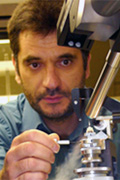Frederick Dyda, Ph.D.

Professional Experience
- Ph.D., University of Pittsburgh, 1992
- B.S., Eötvös Lóránd University, 1986
Research Goal
The goal of our research is to understand how some segments of DNA, called mobile genetic elements (MGE), move within cells and between cells. In general, the reorganization of genomes by MGEs has had a huge impact on the evolution of many organisms. They are one of the drivers of the emergence of antibiotic resistance. Importantly, they can be engineered and used as tools for a variety of genomic applications, including gene therapy.
Current Research
The current focus of the lab is to understand the molecular details of how certain MGEs work and armed with this knowledge to redesign them so they can be part of our gene therapy toolkit. To mobilize DNA, most MGEs encode an enzyme called the transposase that orchestrates a series of molecular events such as DNA recognition, its cleavage, and integration, all mediated by a large nucleoprotein complex called the transpososome. We use a variety of sophisticated experimental and computational tools to understand these processes. In particular, to understand how they work, we use three dimensional structural information at the near-atomic resolution level of these complexes obtained either by single particle cryo-electron microscopy or X-ray diffraction, and a large array of computational tools for both modeling and structure prediction. To visualize the intricacies of their actions, we produce structural “snapshots” of these highly dynamic macromolecular assemblies as they proceed through the path that ends with the MGE integrated at a new genomic location. With these snapshots in hand, we use a variety of biochemical, biophysical, and computational approaches to bridge the structures and biological function and to generate and test ideas of their redesigns.
For more information, see my group on the Structural Biology Section home page.
Applying our Research
One of the most exciting thing about MGEs is their potential application in gene therapy. Some MGEs can deliver large DNA segments and integrate these in the genomes of a variety of different cell types. A detailed mechanistic understanding of how they work could open up a variety of different avenues to modify and optimize MGEs so that clinicians will have them available in the future to treat patients using genetic tools.
Select Publications
- Structural basis of hAT transposon end recognition by Hermes, an octameric DNA transposase from Musca domestica.
- Hickman AB, Ewis HE, Li X, Knapp JA, Laver T, Doss AL, Tolun G, Steven AC, Grishaev A, Bax A, Atkinson PW, Craig NL, Dyda F.
- Cell (2014 Jul 17) 158:353-367. Abstract/Full Text
- Casposase structure and the mechanistic link between DNA transposition and spacer acquisition by CRISPR-Cas.
- Hickman AB, Kailasan S, Genzor P, Haase AD, Dyda F.
- Elife (2020 Jan 8) 9. Abstract/Full Text
Research in Plain Language
Our laboratory focuses on understanding how the large molecules of living systems work. These include the fundamental building blocks of cells: proteins and DNA. The techniques we use include studying these molecules in solution (that is, after we have removed them from cells), but also after we have crystallized them. For instance, by shooting x-rays at these crystals, and measuring the properties of the diffracted x-rays, it is possible to determine the 3-dimensional structure at the resolution of individual atoms. From these structures, we then formulate hypotheses about how these molecules work.

